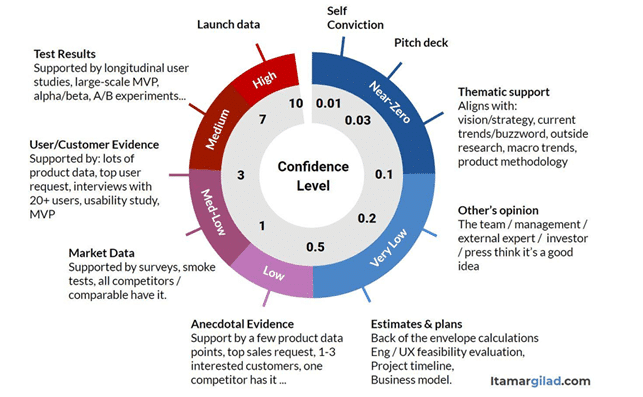The hardest part of being an entrepreneur isn’t coming up with an idea; it’s admitting your idea might not work.
Nearly 10 years ago I started working with startups. I had little prior experience working with founders and no formal education in the field. Nevertheless, I was hired as sort of incubation manager. Shortly after taking up the position, I experienced something that befuddled me. I was shown the office space where the founders were and then let loose. With the expectation to give them advice. “Advice on what?” you may ask. Well, apparently, I had freedom to advise them on whatever the hell I wanted to. With no regards to quality, relevance or framework to guide me as a mentor.
This scenario, I have learned, is not unique. It happens in startup programs all over the world. Every hour of every day. And consequently: Bad advice is killing good startups.
What makes startups work?
As you may have interpretated from this intro, working without a frame of understanding was totally unsatisfying for me. And it marked the beginning of my quest to understand how startups work.
Luckily the second part of my job was to build an accelerator for students in Roskilde. After a short trip to the USA to learn about business model design (and accidentally signing up for day two which was about customer discovery) and equipped only with a pdf from Stanford University labeled “Lean Launchpad: teachers manual” I found on google I designed and ran my first accelerator. The program I copied had a setup consisting of 2-3 world leading startup experts, teachers’ assistants, a mentor corps consisting of top tier investors and the might of Stanford University in the heart of Silicon Valley. We had me and my colleague Andreas.
Nevertheless, Selvstarter allowed me to iteratively explore how to most efficiently guide startups towards a viable business. It was a sandbox where I would redesign the program every half month to include new tools, ideas, frameworks, teaching methodologies and much more. The funny thing about Selvstarter was that the students had less qualifications, less time, less experience, no network and no money. But compared to the “professional founders” in the office space, equipped with nothing but the lean startup methodology some managed to evolve incredibly fast by faking landing pages or selling products that didn’t exist, and so forth. All in the name of accelerating learning which became the overall mission.
One of the startups – Bold Drinks – has gone on to become a very promising scaleup and a renowned and well-known brand in Denmark and Scandinavia. Most of the others died quiet deaths. I took the toolbox and started Validate where I help various organizations, accelerators and startups with creating better entrepreneurs.
Taking my own medicine
Now the reason why you are reading this article is because I recently had my own epiphany. I’ve developed a method to assess startups that will change how we fundamentally work with startups. That is if the market will prove me right. And because of having developed this beautiful new idea I now suffer from a serious case of Inventors Bias (See article 1: When Ideas Strike).
So now I have a great opportunity to take my own medicine and validate my idea from the get-go. This means utilizing everything I’ve learned and coached throughout these last 10 years.
How do you validate an idea?
Great, so we are off to a bad start. The title above is misleading. We are not trying to validate ideas. Nor products. Or features. We want to validate a business model. So, before we discuss this, let’s briefly talk about what a startup is.
A startup is a temporary organization designed to search for a repeatable and scalable business model. – Steve Blank
This wonderful definition tells us everything we need to know as founders. It tells us that our purpose is to find a business model. Our mindset should be that of searching, discovering and learning rather than merely executing a business plan. And finally, that – as a temporary organization – our end-goal is not the startup. No, the startup is the means to becoming something else: An established company.
Now, let’s start with the mindset, as this is probably the hardest part to master. To truly accept the fact that your idea might not work. That what you are working on is probably wrong. To truly listen to the clues your surroundings are giving you and to engage in the discovery process with a learning mindset.
I’ve found the most helpful way of doing this is to try and kill your idea.
How to validate stuff
At this point it might be helpful to define what we mean by validating something. The term comes from the scientific method. And the way we do science is to formulate hypotheses on how the world works and then try to disprove our assumptions. If the scientific community is unable to break the hypothesis through testing, then the theory must hold true. In other words, we need to actively try to kill our idea to validate it.
In the process we might find we need to either tweak (iterate) or change (pivot) our initial thoughts. In some rare cases the initial idea holds water. Statistically it’s most likely to fail. Whether we succeed or fail in killing the idea each outcome should be celebrated as it will give us a chance to leverage our learning. If we are moving our understanding of the world we are on the right path. We want to accelerate learning.
Now typically we tend to talk about validation as something to do with going out of the building. (I’ll cover this part in the coming parts of the series). But a lot of initial work can be done from behind your desk.
Step 1 to validation – AI assisted desk research.
So, after awakening from my creative dream where I invented my framework, I naturally became extremely paranoid. I had two major worries:
- Am I the only one who thinks this is brilliant? (Can be validated through Customer Discovery).
- How come no one has thought of this before? (Desk Research (AND customer discovery).
So, to challenge my raging inventors bias I set out to kill my own idea. I made a long list of all the stuff I could see would challenge my assumptions. At this stage I was not trying to challenge the whole business model yet, we will cover that down the road. But I really wanted to challenge the assumptions I had about the problem. Why is this a big problem? And why is it not being solved in a satisfactory way today?
So, I made a list in Trello with the first 30-40 critical questions or assumptions I could think off needed to be addressed. I put them in our backlog and then started to work on researching each of these questions (a process that is at this point still ongoing). This is where AI has been a complete gamechanger.
How to leverage AI to validate ideas
Our GPT-assistant (lets call it Bob) has allowed me to do both research and simulate and support my thinking in what have been a truly life-transforming process. It is so damn efficient, when you are used to doing it the old way. Especially because Bob is trained in all our learning material. So, it knows our business but also our methodology including our new tool/method.
For instance, to understand how investors would perceive our idea I first asked Bob to research all the leading ways investors are assessing startups today. Then we were able to simulate how these tactics stack up against the capabilities that we will be able to provide. I’m not looking for a yes/no signal at this point. But more like clues as to whether not we are on to something. A way to assess if we are on the right track. Think of the phrase “it’s bad validation but it’s pointing in the right direction”. Validation is an ongoing process and something that matures over time.
Itamar Gilad has a great model to explain how validation isn’t binary. It is something to be gradually achieved through various experiments.

The point is that validation is not a box you check out. Validation should be part of your life for a very long time in the early beginning of your startup’s life. And hopefully inspire you to keep on working agile with a learning mindset throughout the lifetime of your company. This is the secret to why an online bookstore like Amazon ends up building streaming services and launching rocket ships. The power of incremental learning and customer obsession. I digress.
The lack of doing this kind of critical thinking is also startup killer numero uno. Hence, why I take it quite seriously. Basically, we are trying to avoid spending 3 years building something we could have invalidated in 3 months.
Here are some other ways I have leveraged Bob in this initial phase.
- Roleplayed various customer segments.
- Formulated value propositions for each segment.
- Quick assessments on everything from monetization strategies, IP-protection, pricing tactics and strategies, possible moats, possible business models, go-to-market ideas, etc.Competition analysis.
- Research, research, research.
Normally this would probably take me a couple of months. Me and Bob did it in a couple of hours. And in doing so I’ve further trained him in all the stuff he has helped me research.
Also, I found out that some dude in India has already made a framework called the same as mine. His framework sucks, but none-the-less. I need to find a new name.
There’s a reason I named him Bob
Now, if you are as critical with doing AI for research as I was. I hear you. I often catch Bob in making stuff up. And worse. Feeding into my/our bias. Which as I state earlier is one of my biggest fears. So, fact checking and common sense is extremely important. But so is speed. As an early-stage founder, we seldom need to be 100% correct. Because the last 20% take an excruciatingly long time, that’s established-company-with-own-R&D-department territory. So, if the tradeoff is time, we can settle with being 80% right and leave the last 20% to intuition and acceptable risk. Well, depending on your risk tolerance.

Outcome of desk research (so far)
So, with the combined effort of me trying to kill my own idea and Bob assisting me in doing so, I was not able to convince myself that the idea is bad. I found no evidence that the problem was not worth solving, that potential customers would not be willing to pay or that the market was too small to make a viable business. In contrast, I found it would fit as a perfect supplement or alternative to existing solutions, that customers are already paying for existing (yet inferior) alternatives and that potential customers could be everything from founders and investors to governments and public entrepreneurial programs. In other words. I’ve ended up with a raging Bias.

Cue customer discovery
Out of the building
A week after having discovered my initial idea and trying to kill it on my own, I started looking at who I should talk to besides myself and Bob (Which is basically a digital version of me). I already had a meeting booked with a good colleague Nicolai, and he would be the first to be introduced to the solution.
In the next article I will break down the validation process and share my strategy for identifying and prioritizing who I would speak to, tips on making customer discovery, when to break the rules and how to stop you from sabotaging yourself. Which I came close to.
See that’s another point about lean startup that is often mistaken. It does not make the journey easier. It does not make it risk-free or even joyful. It is still difficult, arduous and riddled with possible false-positive signals. And it might not even feel faster than just building and shipping. But it does allow you to mitigate risk and to discover whether you are on the wrong track while still having burn-rate to course correct. And to uncover a problem that’s worth solving. That’s the pay-off.
If you’d like to get the next part of the series directly in your inbox sign up to our newsletter here:




